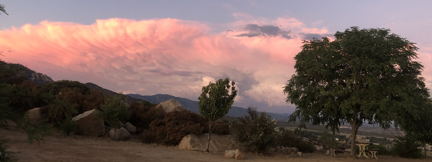Episode #825
November 23, 2024

As I stand in the living room of my modest red cabin, the vaulted A-frame ceiling begins to glow with the warm hues of the setting sun. Through the sliding glass doors on the eastern wall are cumulus thunderheads, painted in delicate shades of orange and pink, drifting in a cerulean sky. Bandit, my black-masked white cat, chatters at the house finches flitting past the patio doors.
The day’s heat has left the air inside the house stuffy and slightly humid, resisting the window cooler’s whining fan.
I unlock the glass door and slide it open, welcoming the evening breeze that sweeps in and instantly refreshes the air.
As I step outside, a bird darts past my head, catching a slow-moving fly in midair. It heads toward the large, fully leafed acacia tree, where it joins its flock in a lively chorus of tweets and twitters. The eighty birds share their stories of the day blending their song with the soft rustling of leaves. Whether they will return to this tree tomorrow or find another sanctuary depends on their collective whim.
Behind me, Bandit meows through the screen door, yearning to chase the birds. But such a pursuit would likely end in her becoming prey to the bobcats and coyotes that roam this mountain chaparral.
A stray raindrop splatters on my head, and I inhale the earthy scent of damp brush and decomposed granite.
To the east, a cliff edged with heliotrope overlooks Cahuilla Valley. In the midst of this rural community, the airport runway lights blink on, stretching down the length of the valley like red Tivoli. To the south, I glimpse Lake Riverside, where small, dark boats bob gently, their fishermen hoping for dinner.
My eyes travel across the amber fields and verdant hillsides to Mount Cahuilla, a rugged granite cinder cone from an ancient volcanic age. Eons ago this south face blew away scattering boulders across the valley. It stands as a testament to time. The mountain is now adorned in native green Desert Broom, Red Shank, and Manzanita. The Desert Broom’s white blossoms lend it a pastel glow, while the Manzanita is heavy with berries. The Red Shank’s bark peels away to reveal a vibrant magenta, and its sprays of white flowers begin to rust. The ground beneath is alive with flowering buckwheat, wild oats, mustard, and prickly poppy plants. Hot pink flowers adorn the beavertail cacti. A mother quail leads her brood from bush to bush while the male stands sentinel on a boulder. Rabbits dash about in their evening frolic.
I begin a leisurely stroll around the exterior of my house. Straight to the east, Thomas Mountain outlines the horizon, a summit of the San Jacinto range that separates my valley from Palm Springs. As my gaze follows the range southward, I see the peak of Santa Rosa, home to a Coachella Indian tribe. The Pacific Crest Trail meanders along this skyline, tracing the undulating ridge of the Beauty Mountains and Mount Palomar. The white dome of Palomar Observatory sits near the summit, a hand’s width to the west, its bright shine blushing red. Farther west lies the Fallbrook mesa of the Cleveland National Forest. Due west, Saddleback Mountain stands, where the sun’s sharp point sinks into its saddle. The sun explodes into a brilliant green flash and bursts into vibrant reds, oranges and lavender. The clouds’ edges glow fluorescent with the reflected light of sunset.

The breeze cools, and the birds quiet down. Cactus flowers close as the first stars begin to shimmer into view. A band of coyotes howl nearby. Bandit whimpers softly as I turn and reenter my little red house.




Very relaxing I feel like I am there…. How peaceful!
Paradise